Savandurga
Savandurga (Kannada: ಸಾವನದುರ್ಗ) is a hill 60 km west of Bengaluru (Karnataka, India) off the Magadi road, in India. The hill is considered to be among the largest monolith hills in Asia.[1] The hill rises to 1226 m above mean sea level and forms a part of the Deccan plateau. It consists of peninsular gneiss, granites, basic dykes and laterites. The Arkavathi river passes nearby through the Thippagondanahalli reservoir and on towards Manchanabele dam.
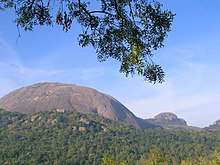
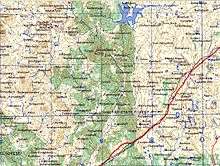
The Savandurga hills are frequented by pilgrims who come to visit the Savandi Veerabhadreshwara Swamy and Narasimha Swamy temple situated at the foothills. Rock climbers, cave explorers and adventurers are among others who frequent the locale. Nearby Manchanabele Dam is a nice place for water sports.
Origin of name
Savandurga is formed by two hills known locally as Karigudda (black hill) and Biligudda (white hill). The earliest record of the name of the hill is from 1340 AD by Hoysala Ballala III from Madabalu where it is called Savandi. Another view is that the name is originated from Samantadurga attributed to a Samantharaya, a governor under Ahchutaraya at Magadi, although there is no inscription confirming this. This was the secondary capital of the Magadi rulers such as Kempegowda. From 1638 to 1728, Mysore took over this place and Dalavayi Devaraja occupied this place with the palace at Nelapattana. In 1791 Lord Cornwallis captured it from Tipu Sultan's forces during the Third Anglo-Mysore War.[2][3] Robert Home in his Select views in Mysore (1794) shows distant views of the hill from Bangalore.[4] He called it Savinadurga or the fort of death. There were no steps to reach the hill top and it was covered by bamboos and other trees forming a barricade.
Megalithic burial urns have been found in the area.[5] Saavana in Sanskrit also means three time rituals.
The main deity of the place is Sri Savandi Veerabhadraswamy Virabhadra. The temple is situated in the foot of the Savandurga hill. The lord Veerabhadraswamy has followers across the south karnataka districts like Bangalore, Ramanagara, Tumkur and Mysore.
There is a Temple of Sri Lakshmi Narasimha Swamy, where there is an Idol of Lord Narasimha has been worshiped for many generations.
Climbing
Savandurga provides for some top class serious slab climbing routes in the world. There are a dozen routes, bolted or otherwise on the south face of the monolith. These range anywhere from 700 to 950 feet of technical climbs, providing sport, trad or a trad-sport mix. Most popular routes include Beladingalu (5.10a sport/trad mix), Simple Monkey Day (5.10a sport), Deepavali set of routes (trad routes with multiple variations that range from 5.7+ G to 5.9 R/X in difficulty). The easiest route is called Cloud 9, a 5.5 rated sport route, and the hardest is Shanti Das, a 5.11D route put up by Lionel Daudet. Most of these routes can be completed in half a day to a day, depending on various factors. Some of the routes have long runouts, and most of them face South or are exposed to South-east, implying that when the sun comes up, the rock becomes quite hot.[6]
Fauna
The hills are home to the endangered yellow-throated bulbuls and were once home to long-billed vultures and white-backed vultures. Other wildlife include sloth bear and leopard.
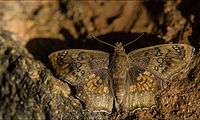 |
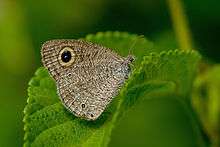 |
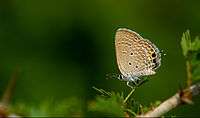 |
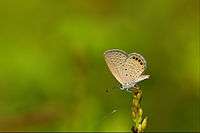 |
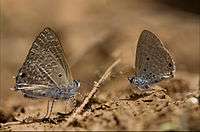 |
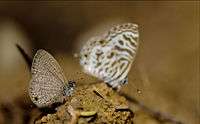 |
| Caprona ransonnetii | Ypthima asterope | Luthrodes contracta | Grass jewel | Pointed ciliate blue (left) and bright babul blue (right) | Common lineblue |
Flora
Surrounding the area is a state forest with scrub and dry deciduous forest covering 27 km2. The degraded forest, which is considered as shrub and tree savanna of the Anogeissus–Chloroxylon–Acacia series is highly diverse, recording over 59 tree and 119 shrub species. Some of the plant species recorded here include:[7]
References
- "Savandurga".
- Wilks, Mark. Historical Sketches of the South of India in an Attempt to Trace the History of Mysoor: from the origin of the Hindoo government of that state, to the extinction of the Mohammedan dynasty in 1799. Edited with notes by Murray Hammick. Mysore: Government Branch Press, 1930-1932.
- Anon. (1908). The Imperial Gazetteer of India. Volume 22. Oxford. p. 150.
- Home, Robert. Select Views in Mysore: the country of Tippoo Sultan from drawings taken on the spot by Mr. Home with historical descriptions. First publ. London: Bower, 1794.
- Branfill, BR (1881) On the Savandurga rude stone cemetery, central Maisur. Indian Antiquary 10:1-12
- https://www.mountainproject.com/v/savandurga-hill/111646874/
- K. S. Murali, A. Kavitha, and R. P. Harish (2003) Spatial patterns of tree and shrub species diversity in Savanadurga State Forest, Karnataka. Current Science, 84(6):808-813
External links
| Wikimedia Commons has media related to Savandurga. |